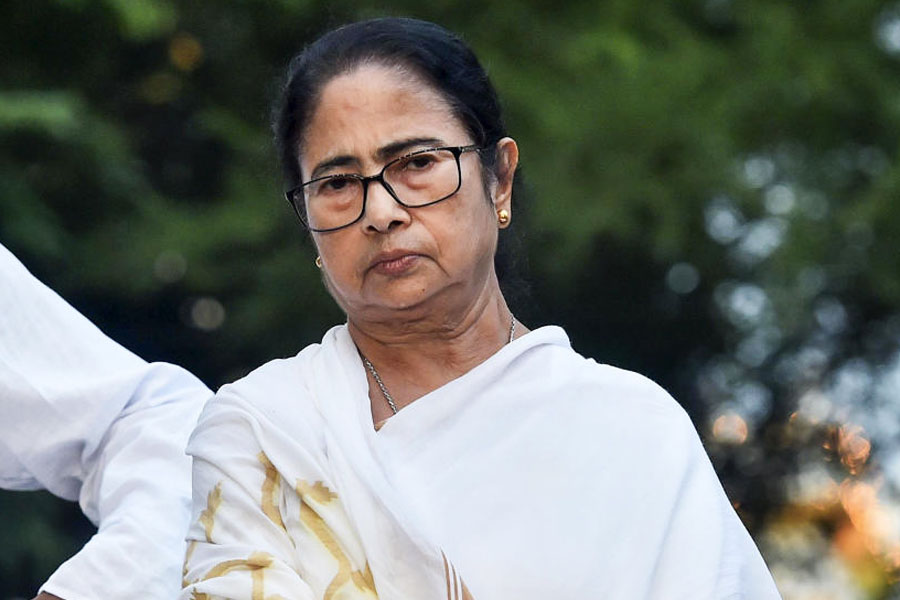 |
 |
| Stage craft: An artist (above) at the Kidderpore pandal designed by Sushanto Pal; Pal (top, second from left) with his team at Bondel Road |
Easels, sketchbooks and tubes of oil paint lie scattered amidst beaten iron sheets and cylindrical fibre-glass props. Two young men, clad in jeans and kurta, apply daubs of yellow-ochre paint on the props. Another fixes some copper filigree onto the iron sheets. No, it’s not an artist’s workshop. It’s the interior of the Ekushey Pally Durga Puja pandal on Bondel Road in south Calcutta. And the three young men are third-year undergraduate students studying Bachelor of Fine Arts (BFA) at Calcutta’s Government College of Art and Craft (GCAC).
The young men — Sunny Das, Dipankar Dey and Krishnendu Tikadar — have been hired by Sushanto Pal, a costume and interior designer and an art director in Bengali films, to help him design the pandal. Pal has a masters degree from GCAC, and is better known as a “star” Durga Puja artist, responsible for the concept, design and execution of idols and pandals.
“We are interpreting how Goddess Durga got shaped out of a male chauvinistic concept where three Hindu gods created her,” says Pal, who is not only making a gigantic tri-coloured idol (red for Brahma, yellow for Vishnu and blue for Maheshwar or Shiv), but designing the light and sound in the backdrop as well. “The theme is so abstract that you need institutionally-trained artists to execute it,” says Pal
Purists might shudder at the idea of a tri-coloured Durga idol as a symbol of “male chauvinism” in the Hindu pantheon, but Pal is in high demand. He is designing two other Pujas in Kalighat and Kidderpore and there are 11 art college students working with him on this year’s Pujas. Apart from students from GCAC, undergraduates from two other art colleges — the Rabindra Bharati University (RBU) and the Indian College of Arts and Draftsmanship (ICAD) are also helping him with the work.
Pal and his assistants are among a rising number of artists and art college graduates in Calcutta who transform the four-day Durga Pujas into a stunning display of installation art. Over the past few years, the involvement of these institutionally-trained artists — who combine elements of modern sculpture, architecture, painting and traditional craft — has been changing the visual profile of the ancient ritual. The Pujas afford them a welcome opportunity to try their hands at aesthetic experiments and also rake in the moolah.
The involvement of art college students in the Pujas is not exactly new. But these days they work not just on the idol, but on the whole spectacle of the Pujas — including executing a theme (which could range from ancient Egyptian to a Titanic disaster), light, sound and, of course, the pandal.
Says sculptor Tapas Sarkar who graduated from GCAC in 1975. “Many artists started with sculpting idols of Saraswati Puja, which is held on a much smaller scale than Durga Puja. If they succeeded, they were asked to work on the colossal Durga idol too.”
Sarkar says that though the extra buck was the obvious incentive, it was also an opportunity for them to exercise their creative potential. “However, the scope was limited because the puja budget used to be quite meagre in those days,” he says.
That changed in the mid-1980s with the arrival of hefty corporate sponsorships. “The trend took off when a paint company announced an award for aesthetic decorations of the idol and the pandal,” says Parag Ray, dean, faculty of fine arts, RBU.
The mad rush for awards led to the puja organisers hiring more and more art college graduates to turn out spectacular theme-based pujas. Corporate sponsorship too poured in, raising the budget of pujas.
Today’s big-budget Durga Puja — which can go up to Rs 60 lakh — has become an irresistible work option for many art students. In fact, artists like Pashupati Rudra Pal, Sanatan Dinda and Bhabatosh Sutar— all trained from GCAC — have used the festival as a stepping stone to their careers as painters.
“The Pujas enable us to experiment with installations which no art college can finance,” says sculptor and painter Partha Dasgupta. “In 2005, organisers of a south Calcutta puja allowed me to buy iron materials at a cost of Rs 18 lakh for an installation,” he says.
For many art students, theme pujas are like three-month paid internships. “This is a big learning experience and our first interface with the market and the masses,” says Dipankar Dey, who is working on the Ekushe Pally Puja. For Jayanta Basak, a final-year student at ICAD, who has two assignments this year, the festival is an opportunity to showcase his talent. “Unlike in the galleries, the Pujas help us reach out to thousands of people, ” says Basak.
Of course, the involvement of artists in the Pujas is not just about art. It is also about hard cash. Many of these artists, who struggle to find success and recognition in the cut-throat art market, make more money (as much as Rs 5 lakh per puja in some cases) out of these four festival days than they do in the entire year.
“The involvement of trained artists in the Pujas has to do with the city’s dysfunctional art market, which has led to many of them looking for alternative avenues for work,” says Sunanda K. Sanyal, an art historian and associate professor, Lesley University at Boston, US. Agrees Ray of RBU, “Many of the graduates find openings as interior decorators and the world of advertising after working on community pujas.”
Some believe that by getting involved with the Pujas, artists are creating significant pieces of art. “There’s been a silent art revolution in the city during the Pujas, which is now being recognised by art critics, both in India and abroad.” Concurs Dasgupta, referring to the fact that famous German installation artist Gregor Schneider took up the task of designing the facade of the immensely popular Ekdalia Evergreen Club Puja pandal this year.
Art historians like Sanyal, however, are loath to dub Durga Puja art as installation art. “Installation — as the term is used in the contemporary art context — originated in a specific avant-garde art practice in the West, and isn’t applicable to any temporary structure or arrangement, no matter how creative it is.” According to him, the so-called Puja art is restricted by its ritual and spiritual moorings, which prevents the artist from taking unlimited creative licence.
The lack of freedom and interference by puja organisers come in the way of an artist’s expression, says Dasgupta, who quit working on the pujas five years ago for this reason. “There was also an uneasy feeling of being pushed into competition, sometimes without my consent.” Indeed, so intense is the competition among organisers that sometimes artists are even refused a part of their fees if they fail to bag an award.
But all that is par for the course for the hundreds of artists who take time out from their daily grind to get a toehold in the traditional art world and work night and day to turn out an awe-inspiring Durga Puja. The money helps no doubt. But if for a few fleeting moments people are wonder-struck by their creation, that too is no mean reward.










